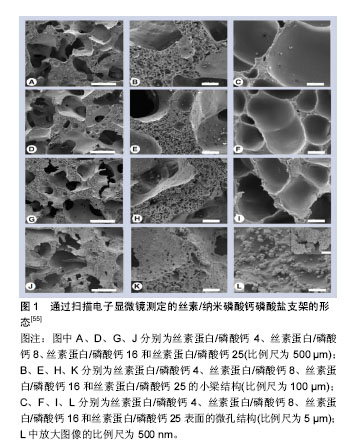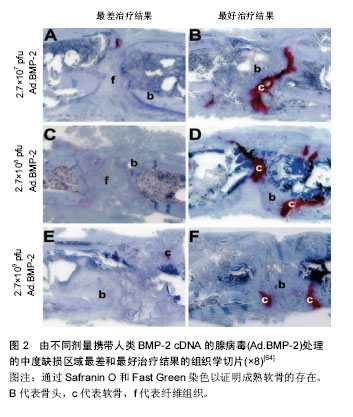| [1] Agarwal R,Garcia AJ.Biomaterial strategies for engineering implants for enhanced osseointegration and bone repair.Adv Drug Deliver Rev. 2015;94:53-62.[2] Mueller TL,Wirth AJ,van Lenthe GH,et al.Mechanical stability in a human radius fracture treated with a novel tissue-engineered bone substitute: a non-invasive, longitudinal assessment using high-resolution pQCT in combination with finite element analysis.J Tissue Eng Regen Med.2011;5(5): 415-420.[3] Patwardhan S,Shyam AK,Mody RA,et al.Reconstruction of bone defects after osteomyelitis with nonvascularized fibular graft: a retrospective study in twenty-six children.J Bone and Joint Surg Am. 2013;95(9):e56,S1.[4] 李远辉,杨运发,胡汉生,等.带血管腓骨移植修复四肢大段骨缺损:可有效促进骨愈合[J].中国组织工程研究, 2015,19(11):1641-1646.[5] Chatterjea A,Meijer G,van Blitterswijk C,et al.Clinical application of human mesenchymal stromal cells for bone tissue engineering.Stem Cells Int.2010;2010:215625.[6] Zhong WJ,Sumita Y,Ohba S,et al.In Vivo Comparison of the Bone Regeneration Capability of Human Bone Marrow Concentrates vs. Platelet-Rich Plasma.PloS One.2012;7(7):e40833.[7] Schmitt CM,Doering H,Schmidt T,et al.Histological results after maxillary sinus augmentation with Straumann(R) BoneCeramic, Bio-Oss(R), Puros(R), and autologous bone. A randomized controlled clinical trial. Clin Oral Implan Res.2013;24(5):576-585.[8] Chiodo CP,Hahne J,Wilson MG,et al.Histological Differences in Iliac and Tibial Bone Graft.Foot Ankle Int.2010;31(5):418-422.[9] Hyer CF,Berlet GC,Bussewitz BLW,et al.Quantitative Assessment of the Yield of Osteoblastic Connective Tissue Progenitors in Bone Marrow Aspirate from the Iliac Crest, Tibia, and Calcaneus.J Bone Joint Surg Am.2013;95A(14):1312-1316.[10] [10]Smith CA,Richardson SM,Eagle MJ,et al.The use of a novel bone allograft wash process to generate a biocompatible, mechanically stable and osteoinductive biological scaffold for use in bone tissue engineering.J Tissue Eng Regen Med.2015;9(5):595-604.[11] 左健,康建敏,潘乐.同种异体骨移植用于骨缺损修复的应用现状[J].中国组织工程研究,2012,16(18): 3395-3398.[12] Li J,Wang Z,Guo Z,et al.The Use of Allograft Shell With Intramedullary Vascularized Fibula Graft for Intercalary Reconstruction After Diaphyseal Resection for Lower Extremity Bony Malignancy.J Surg Oncol.2010;102(5):368-374.[13] Wei L,Miron RJ,Shi B,et al.Osteoinductive and Osteopromotive Variability among Different Demineralized Bone Allografts.Clin Implant Dent Res.2015;17(3):533-542.[14] Sbordone C,Toti P,Guidetti F,et al.Volumetric changes after sinus augmentation using blocks of autogenous iliac bone or freeze-dried allogeneic bone. A non-randomized study. J Craniomaxillofac Surg. 2014;42(2):113-118.[15] Soardi CM,Zaffe D,Motroni A,et al.Quantitative Comparison of Cone Beam Computed Tomography and Microradiography in the Evaluation of Bone Density after Maxillary Sinus Augmentation: A Preliminary Study. Clin Implant Dent Relat Res.2014;16(4):557-564.[16] Ghanaati S,Barbeck M,Booms P,et al.Potential lack of "standardized" processing techniques for production of allogeneic and xenogeneic bone blocks for application in humans.Acta Biomater.2014;10(8): 3557-3562.[17] Kubosch EJ,Bernstein A,Wolf L,et al.Clinical trial and in-vitro study comparing the efficacy of treating bony lesions with allografts versus synthetic or highly-processed xenogeneic bone grafts. BMC Musculoskel Dis.2016;17:77.[18] 张屹,陈建常,史振满.异种骨支架及其衍生材料治疗骨缺损的研究现状与进展[J].中国矫形外科杂志,2014, 22(14):1277-1279.[19] Gruskin E,Doll BA,Futrell FW,et al.Demineralized bone matrix in bone repair: history and use.Adv Drug Deliver Rev.2012;64(12):1063-1077.[20] Schubert T,Lafont S,Beaurin G,et al.Critical size bone defect reconstruction by an autologous 3D osteogenic-like tissue derived from differentiated adipose MSCs.Biomaterials.2013;34(18):4428-4438.[21] Hou T,Li Z,Luo F,et al.A composite demineralized bone matrix--self assembling peptide scaffold for enhancing cell and growth factor activity in bone marrow.Biomaterials.2014;35(22):5689-5699.[22] van Bergen CJ,Kerkhoffs GM,Ozdemir M,et al.Demineralized bone matrix and platelet-rich plasma do not improve healing of osteochondral defects of the talus: an experimental goat study. Osteoarthr Cartilag.2013;21(11):1746-1754.[23] Xing J,Mei T,Luo K,et al.A nano-scaled and multi-layered recombinant fibronectin/cadherin chimera composite selectively concentrates osteogenesis-related cells and factors to aid bone repair.Acta Biomater. 2017;53:470-482.[24] 毛克政,毛克亚,程自申,等.nHA/α-CSH复合植骨材料的研制及其固化时间和抗压强度测定[J].医用生物力学,2013,28(3):333-337.[25] Trombelli L,Simonelli A,Pramstraller M,et al.Single Flap Approach With and Without Guided Tissue Regeneration and a Hydroxyapatite Biomaterial in the Management of Intraosseous Periodontal Defects. J Periodontol.2010;81(9):1256-1263.[26] Wu XH,Wu ZY,Su JC,et al.Nano-hydroxyapatite promotes self-assembly of honeycomb pores in poly(L-lactide) films through breath-figure method and MC3T3-E1 cell functions.Rsc Adv.2015;5(9): 6607-6616.[27] 宋华,任向前,未东兴.纳米羟基磷灰石对缺损骨再生的影响[J].中国组织工程研究,2015,19(8):1155-1159.[28] Atak BH,Buyuk B,Huysal M,et al.Preparation and characterization of amine functional nano-hydroxyapatite/chitosan bionanocomposite for bone tissue engineering applications. Carbohydr Polym. 2017;164: 200-213.[29] Venkatesan J,Kim SK.Nano-hydroxyapatite composite biomaterials for bone tissue engineering--a review.J Biomed Nanotechnol. 2014;10(10): 3124-3140.[30] Zhu Y,Yang Q,Yang M,et al. Protein Corona of Magnetic Hydroxyapatite Scaffold Improves Cell Proliferation via Activation of Mitogen-Activated Protein Kinase Signaling Pathway.ACS Nano.2017; 11(4):3690-3704.[31] Jakus AE,Rutz AL,Jordan SW,et al.Hyperelastic "bone": A highly versatile, growth factor-free, osteoregenerative, scalable, and surgically friendly biomaterial.Sci Transl Med.2016;8(358): 358ra127.[32] Pina S,Oliveira JM,Reis RL.Natural-based nanocomposites for bone tissue engineering and regenerative medicine: a review.Adv Mater. 2015;27(7):1143-1169.[33] Castro AG,Polini A,Azami Z,et al.Incorporation of PLLA micro-fillers for mechanical reinforcement of calcium-phosphate cement.J Mech Behav Biomed.2017;71:286-294.[34] Fukuda N,Tsuru K,Mori Y,et al.Fabrication of self-setting beta-tricalcium phosphate granular cement.J Biomed Mater Res B Appl Biomater.2017.doi: 10.1002/jbm.b.33891. [Epub ahead of print][35] Zhang J,Liu W,Schnitzler V,et al.Calcium phosphate cements for bone substitution: chemistry, handling and mechanical properties.Acta Biomater.2014;10(3):1035-1049.[36] Zhang JT,Liu WZ,Gauthier O,et al.A simple and effective approach to prepare injectable macroporous calcium phosphate cement for bone repair: Syringe-foaming using a viscous hydrophilic polymeric solution. Acta Biomater.2016;31:326-338.[37] Zhao L,Burguera EF,Xu HH,et al.Fatigue and human umbilical cord stem cell seeding characteristics of calcium phosphate-chitosan-biodegradable fiber scaffolds.Biomaterials. 2010; 31(5):840-807. [38] 《中国组织工程研究与临床康复》杂志社学术部.医用金属材料相关产品的应用现状和发展趋势[J].中国组织工程研究与临床康复, 2010,14(51): 9621-9622.[39] Albrektsson T,Jansson T,Lekholm U.Osseointegrated dental implants. Dent Clin North Am.1986;30(1): 151-174.[40] Strakowska P,Beutner R,Gnyba M,et al.Electrochemically assisted deposition of hydroxyapatite on Ti6Al4V substrates covered by CVD diamond films - Coating characterization and first cell biological results.Mater Sci Eng C Mater Biol Appl.2016;59:624-635.[41] Balla VK,Bodhak S,Bose S,et al.Porous tantalum structures for bone implants: fabrication, mechanical and in vitro biological properties.Acta Biomater.2010;6(8):3349-3359.[42] Balla VK,Banerjee S,Bose S,et al.Direct laser processing of a tantalum coating on titanium for bone replacement structures.Acta Biomater. 2010;6(6):2329-2334.[43] 耿丽鑫,甘洪全,王茜,等.国产多孔钽对成骨细胞生物相容性及其相关成骨基因表达的影响[J].第三军医大学学报,2014,36(11):1163-1167.[44] Jahan K,Tabrizian M.Composite biopolymers for bone regeneration enhancement in bony defects. Biomater Sci-UK.2016;4(1):25-39.[45] Mottaghitalab F,Hosseinkhani H,Shokrgozar MA,et al.Silk as a potential candidate for bone tissue engineering.J Control Release. 2015;215:112-128.[46] 陈亮.丝素蛋白支架在骨组织工程中的应用进展[J].中华骨科杂志, 2016, 14(36):932-937. [47] Perrone GS, Leisk GG, Lo TJ, et al.The use of silk-based devices for fracture fixation.Nat Commun.2014;5:3385.[48] Ran J,Hu J,Sun G,et al.A novel chitosan-tussah silk fibroin/nano- hydroxyapatite composite bone scaffold platform with tunable mechanical strength in a wide range.Int J Biol Macromol. 2016;93 (Pt A):87-97.[49] Yassin MA,Mustafa K,Xing Z,et al.A Copolymer Scaffold Functionalized with Nanodiamond Particles Enhances Osteogenic Metabolic Activity and Bone Regeneration.Macromol Biosci. 2017;17(6).doi: 10.1002/mabi.201600427. Epub 2017 Jan 24. [50] Puppi D,Mota C,Gazzarri M,et al.Additive manufacturing of wet-spun polymeric scaffolds for bone tissue engineering.Biomed Microdevices. 2012;14(6):1115-1127.[51] Chen X,Gleeson SE,Yu T,et al.Hierarchically Ordered Polymer Nanofiber Shish Kebabs as a Bone Scaffold Material.J Biomed Mater Res A.2017;105(6):1786-1798.[52] Ding Y,Li W,Muller T,et al.Electrospun Polyhydroxybutyrate/Poly (epsilon-caprolactone)/58S Sol-Gel Bioactive Glass Hybrid Scaffolds with Highly Improved Osteogenic Potential for Bone Tissue Engineering.ACS Appl Mater Inter.2016;8(27):17098-17108.[53] Yousefi AM,James PF,Akbarzadeh R,et al. Prospect of Stem Cells in Bone Tissue Engineering: A Review. Stem Cells Int. 2016;2016: 6180487.[54] Bose S,Roy M,Bandyopadhyay A.Recent advances in bone tissue engineering scaffolds.Trends Biotechnol.2012;30(10):546-554.[55] Yan LP,Silva-Correia J,Correia C,et al.Bioactive macro/micro porous silk fibroin/nano-sized calcium phosphate scaffolds with potential for bone-tissue-engineering applications.Nanomedicine (Lond). 2013;8(3): 359-378.[56] Nejadnik MR,Yang X,Bongio M,et al.Self-healing hybrid nanocomposites consisting of bisphosphonated hyaluronan and calcium phosphate nanoparticles.Biomaterials. 2014;35(25): 6918-6929.[57] Chae T,Yang H,Leung V,et al.Novel biomimetic hydroxyapatite/alginate nanocomposite fibrous scaffolds for bone tissue regeneration.J Mater Sci Mater Med.2013;24(8):1885-1894.[58] Salter E,Goh B,Hung B,et al.Bone tissue engineering bioreactors: a role in the clinic?. Tissue Eng Part B Rev.2012;18(1):62-75.[59] Brunello G,Sivolella S,Meneghello R,et al.Powder-based 3D printing for bone tissue engineering. Biotechnol Adv.2016;34(5):740-753.[60] Kang HW,Lee SJ,Ko IK,et al.A 3D bioprinting system to produce human-scale tissue constructs with structural integrity.Nat Biotechnol. 2016;34(3):312-319.[61] Rezvani Z,Venugopal JR,Urbanska AM,et al.A bird's eye view on the use of electrospun nanofibrous scaffolds for bone tissue engineering: Current state-of-the-art, emerging directions and future trends. Nanomedicine.2016;12(7):2181-2200.[62] Evans CH.Gene delivery to bone.Adv Drug Deliver Rev. 2012;64(12): 1331-1340.[63] Baltzer AW,Lattermann C,Whalen JD,et al.Genetic enhancement of fracture repair: healing of an experimental segmental defect by adenoviral transfer of the BMP-2 gene.Gene Ther.2000;7(9):734-739.[64] Betz VM,Betz OB,Glatt V,et al.Healing of segmental bone defects by direct percutaneous gene delivery: effect of vector dose.Hum Gene Ther.2007;18(10):907-915.[65] Zhang Y,Cheng N,Miron R,et al.Delivery of PDGF-B and BMP-7 by mesoporous bioglass/silk fibrin scaffolds for the repair of osteoporotic defects.Biomaterials.2012;33(28):6698-6708.[66] Lu CH,Chang YH,Lin SY,et al.Recent progresses in gene delivery-based bone tissue engineering. Biotechnol Adv. 2013;31(8): 1695-1706. |
.jpg)


.jpg)
.jpg)